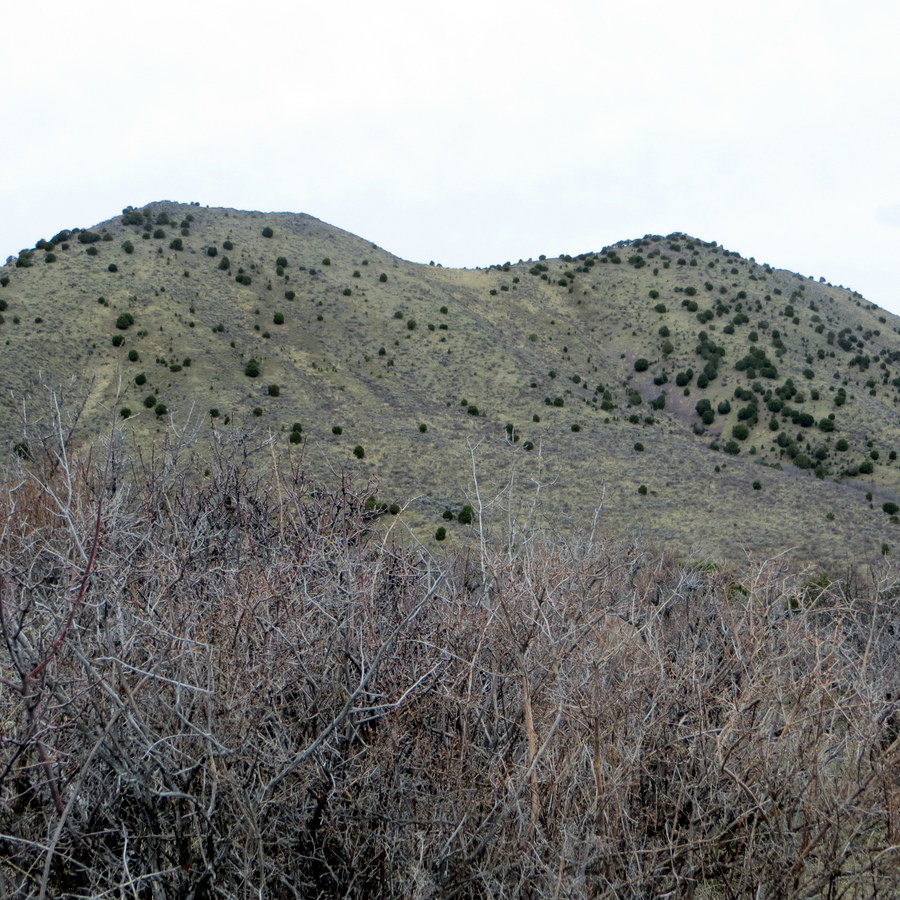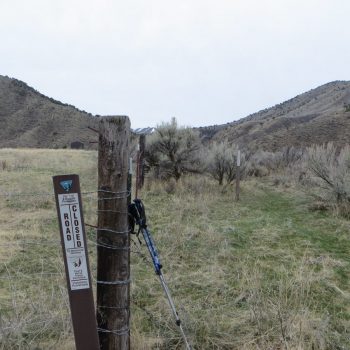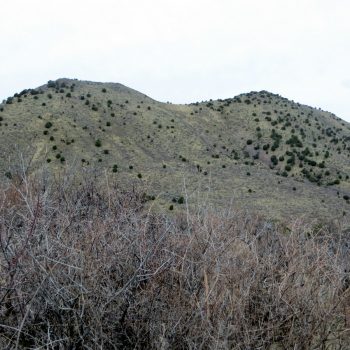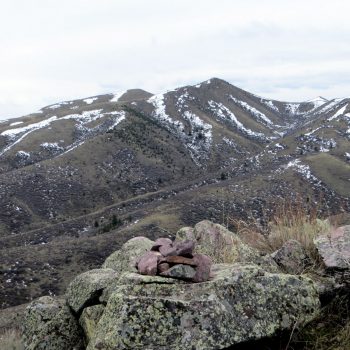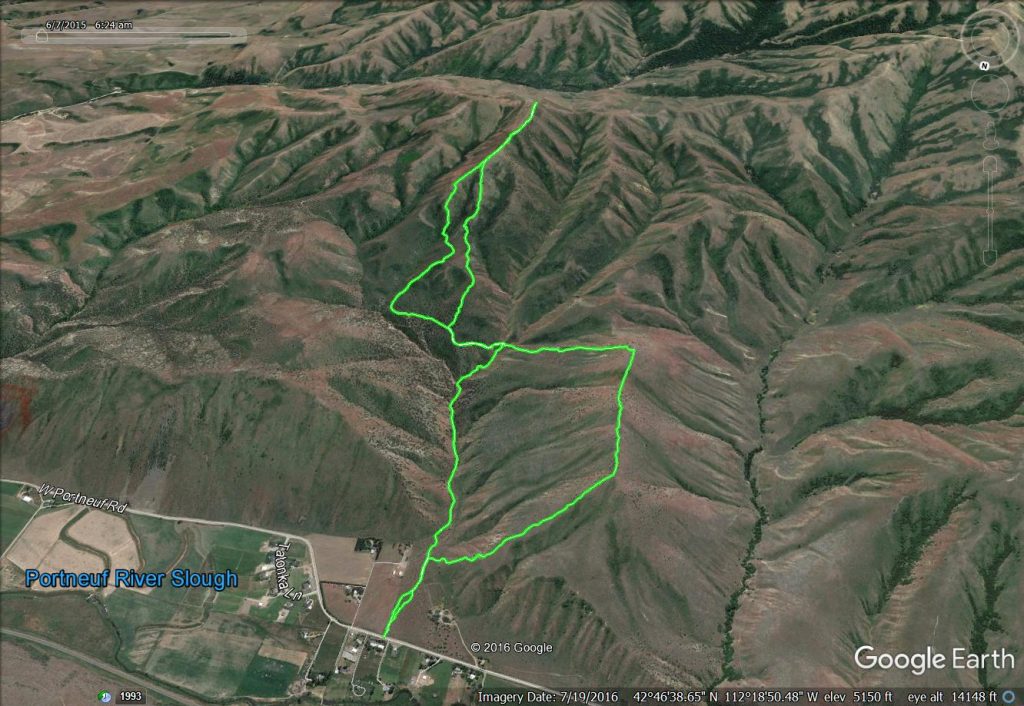Elevation: 5,762 ft
Prominence: 302
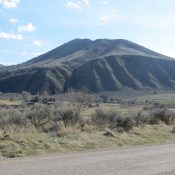
This peak is not in the book. There are two route descriptions set out below. The first by Livingston Douglas is the most current and is the recommended description because of his updates on access. The second by Margo Mandella describes the climb and includes photos that demonstrate the type of terrain the route crosses. Updated November 2019
Peak 5762 is located in the Bannock Range. The peak lies on public land managed by the Bureau of Land Management (BLM). The peak is 3.62 miles southwest of the town of Inkom, ID and 2.61 miles northeast of Indian Mountain. Peak 5762 is best climbed from the north and can be combined with Peak 6495 via a loop route for an early-season, double-peak outing. USGS Inkom
Peak 5762 by Livingston Douglas
West Face/North Ridge, Class 2
Access
The Papoose Creek BLM “trailhead” is located at a green cattle gate about 100 feet south of the junction of Portneuf Road and Blackroad Road, on the right/west side of Portneuf Road. The aforementioned junction is 1.9 miles east of Fort Hall Mine Road on the east side of the town of Portneuf, ID. The cattle gate is closed but is not locked. Park alongside Portneuf Road in a pullout between the stop sign (with nearby mailboxes) and the green cattle gate. The elevation here is 4,528 feet.
The Climb
According to the Pocatello BLM office, this is the only public access to Peak 5762 from the north. The south side access via Indian Creek Road is closed to the public. The BLM trail crosses private land for the first ½ mile or so. BLM currently has an easement with the landowner, as is indicated on the trail signs. STAY ON THE TRAIL.
Note that there are NO BLM SIGNS at the green cattle gate. Neither are there any “No Trespassing” signs. Open and close the green cattle gate. Follow a weak footpath that soon crosses to the right/west side of [small] Papoose Creek. The footpath soon turns into a trail and follows the right/west side of a cattle fence. This trail is signed as a “BLM Easement” trail. The trail gains elevation and moves right/west away from the creek/fence and climbs over two shoulders. The trail then works its way back toward Papoose Creek and reaches an “Entering Public Lands” sign.
Shortly after reaching public land, leave the trail and descend steeply (about 50 vertical feet) to Papoose Creek on a cattle trail. Cross the small creek and begin the steep climb up the west face of the north ridge of Peak 5762. This is a steep scrub slope, but it goes reasonably well. As you approach the north ridge, boulders and junipers enter the mix. Once on the ridge, follow the somewhat choppy, clogged ridge southward to the [lower] north summit. This summit had a small cairn on it.
Continue south along the ridge, dropping about 100 vertical feet to a saddle. Continue south to the narrow, elongated true summit of Peak 5762. The ridge crest is a combination of rock and scrub. The high point and summit cairn are located at the south end of the narrow, rocky outcrop.
South Ridge, Class 2
Access
Same as for the west face/north ridge
The Descent
From the rocky summit, descend south-southeast on Class 2/2+ boulders with scrub/brush mixed in and scattered junipers nearby. The terrain soon becomes an easy grassy slope that leads down to the gentle saddle.
Peak 5762 by Margo Mandella
Getting There
The most challenging part of the climb might be finding the trailhead, which is located on a strip of public land between two private residences. Starting from Pocatello, take the Bannock Highway (which roughly parallels the west side of I-15) southeast to West Portneuf Road and head east toward Inkom. At the intersection of West Portneuf Road and West Blackrock Road, turn southeast/right and continue on West Portneuf Road.
As you drive, look toward your right/south for a BLM trail marker that is next to a fence post. The marker is not easy to spot, and there is no parking area or pull-off. But, if you pass a private drive on your right that is signed “Dead End” or Tatonka Lane on your left, you drove too far. When you find the marker, the only legal option to park is on the narrow road shoulder or, as we did…slightly off-road, straddling the small ditch.
The Climb, Class 2
Hike south through this strip of land, using one of several “paths” until you reach a gate. The gate was open in March 2017, and there was no indication that it is ever closed. Peak 5762 lies to your immediate right/west.
We climbed this peak with Peak 6495 via the loop route (shown in the GPS track, below). If Peak 5762 is your only destination, pass through the gate and start south on a discernible trail into Trough Canyon.
Before you go too far, you have two choices. Decide if you want to immediately climb off-trail to reach the northeast ridge or if you want to hike farther in the canyon and climb to the saddle between the peak’s north and south summits. Effort-wise, the routes are about the same. The bottom loop shown on the GPS track essentially shows both ways. Ignore the loop that continues toward Peak 6495.
If you hike into Trough Canyon to the saddle, stay to your right at all junctions to stay out of Morris Canyon. Hike for about a mile. At this point, you reach another junction where you can clearly see the peak’s south summit. Here, go off-trail to your right/west and climb up the ridge, aiming for either the saddle (or directly to the summit). At the saddle, the true summit is the one to the south.
The views of Peak 6495, Peak 8037, Indian Mountain, Walker Benchmark, Scout Mountain and Portneuf Range Peaks (e.g., Bonneville Peak, Snow Peak, and Haystack Mountain) are really nice!
The Descent, Class 2
When you’ve finished enjoying the views, reverse your route to the trailhead. Alternatively, continue north along the ridge, climb the north summit and when you reach the northeast ridge, take that down. If you noticed on the way up, Trough Canyon’s walls are steep along several sections of the canyon. Pitching off the peak anywhere other than the saddle/south summit area or the northeast ridge could “cliff” you out.
Additional Resources
Regions: Bannock Range->SOUTHERN IDAHO
Mountain Range: Bannock Range
Longitude: -112.3209 Latitude: 42.7782
